
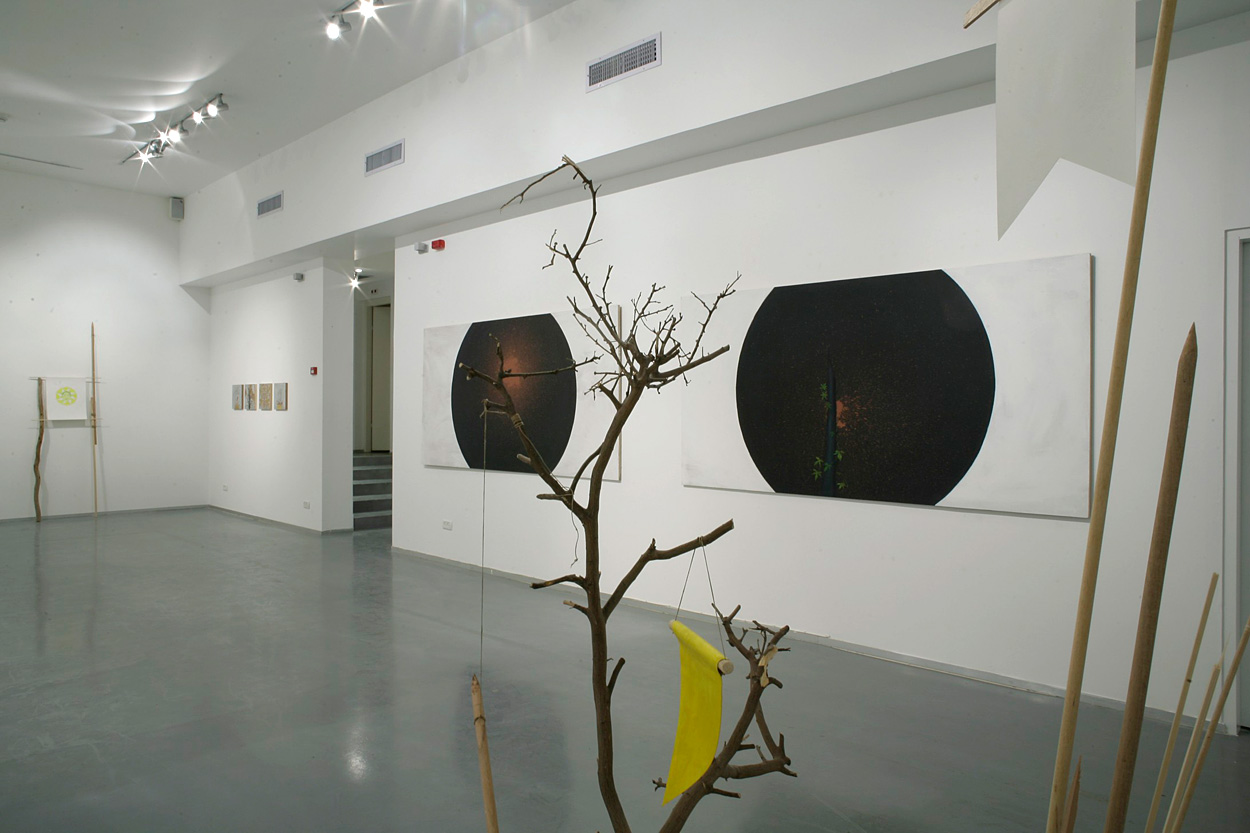



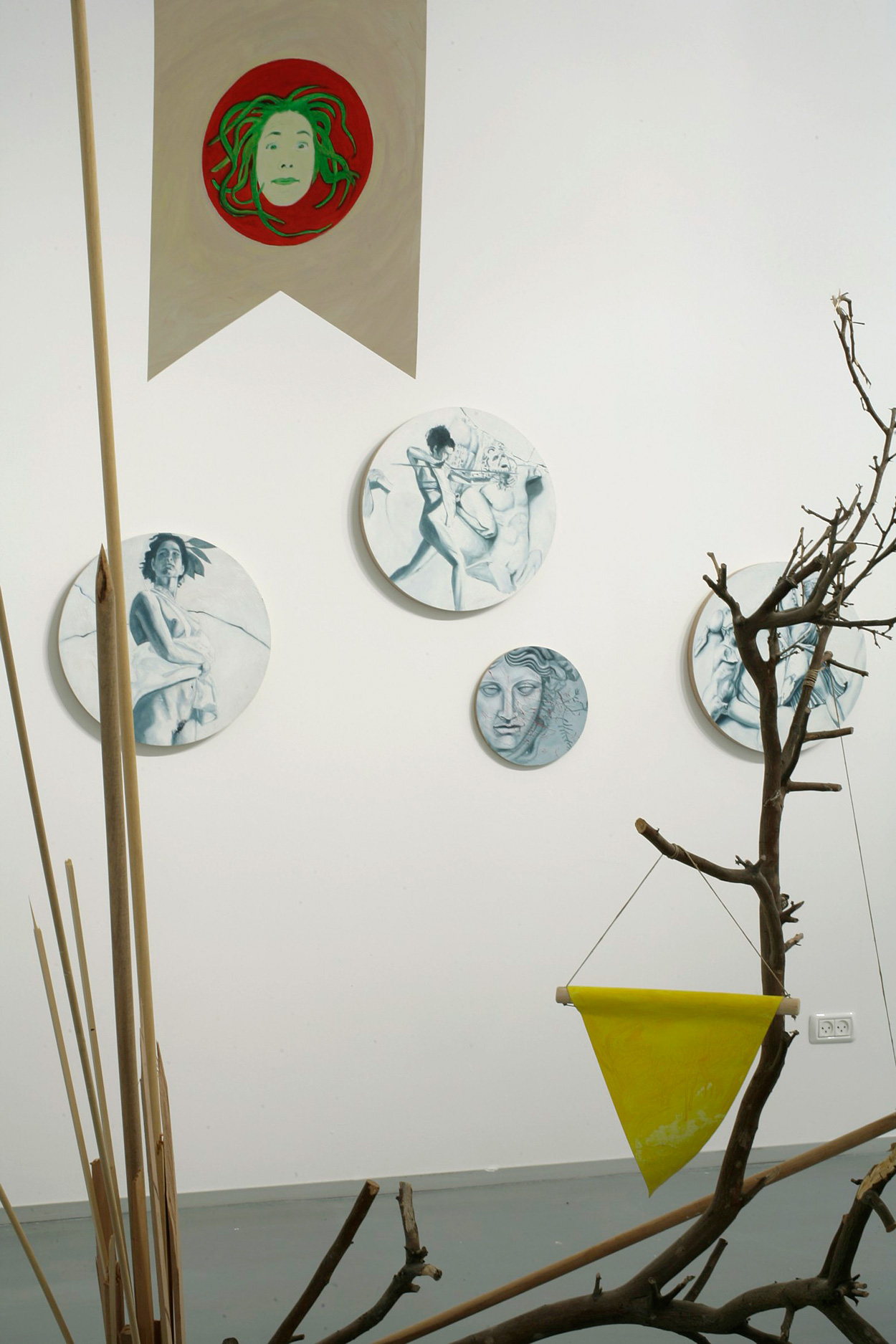
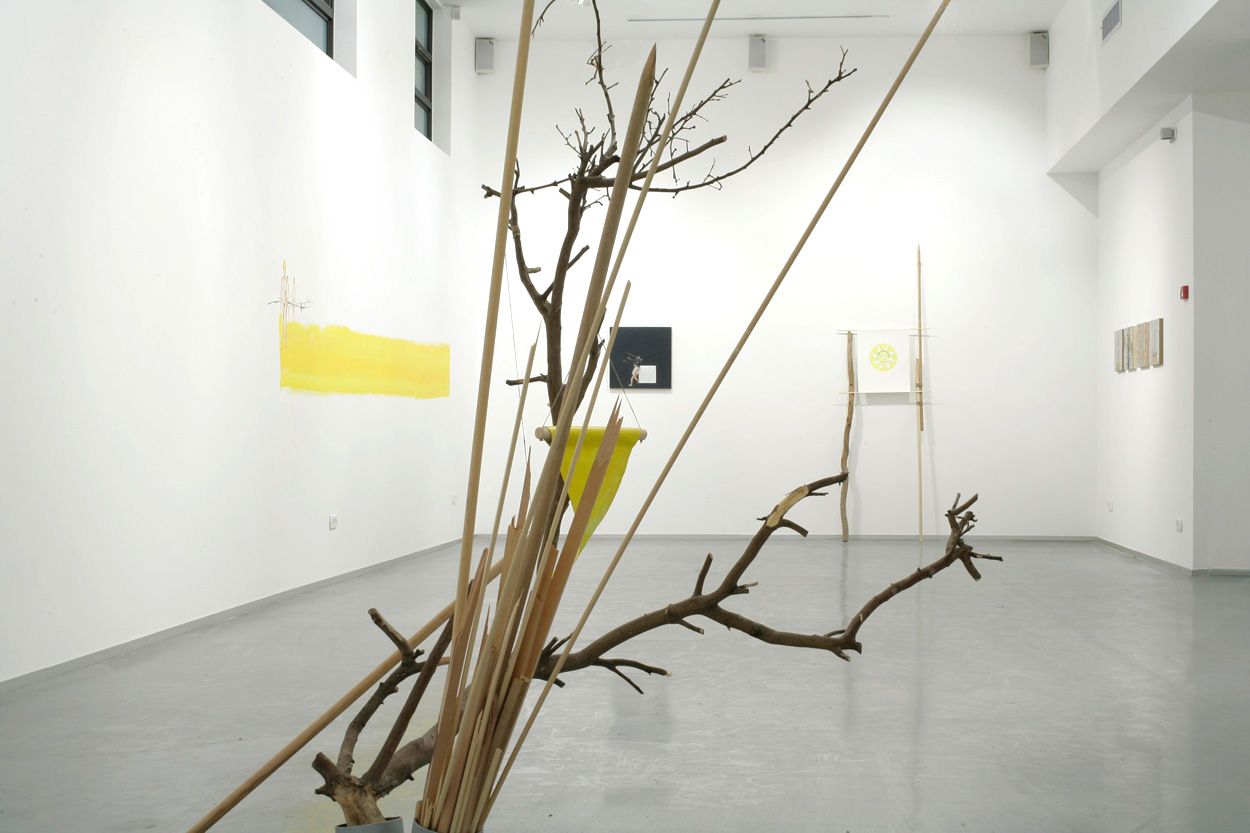

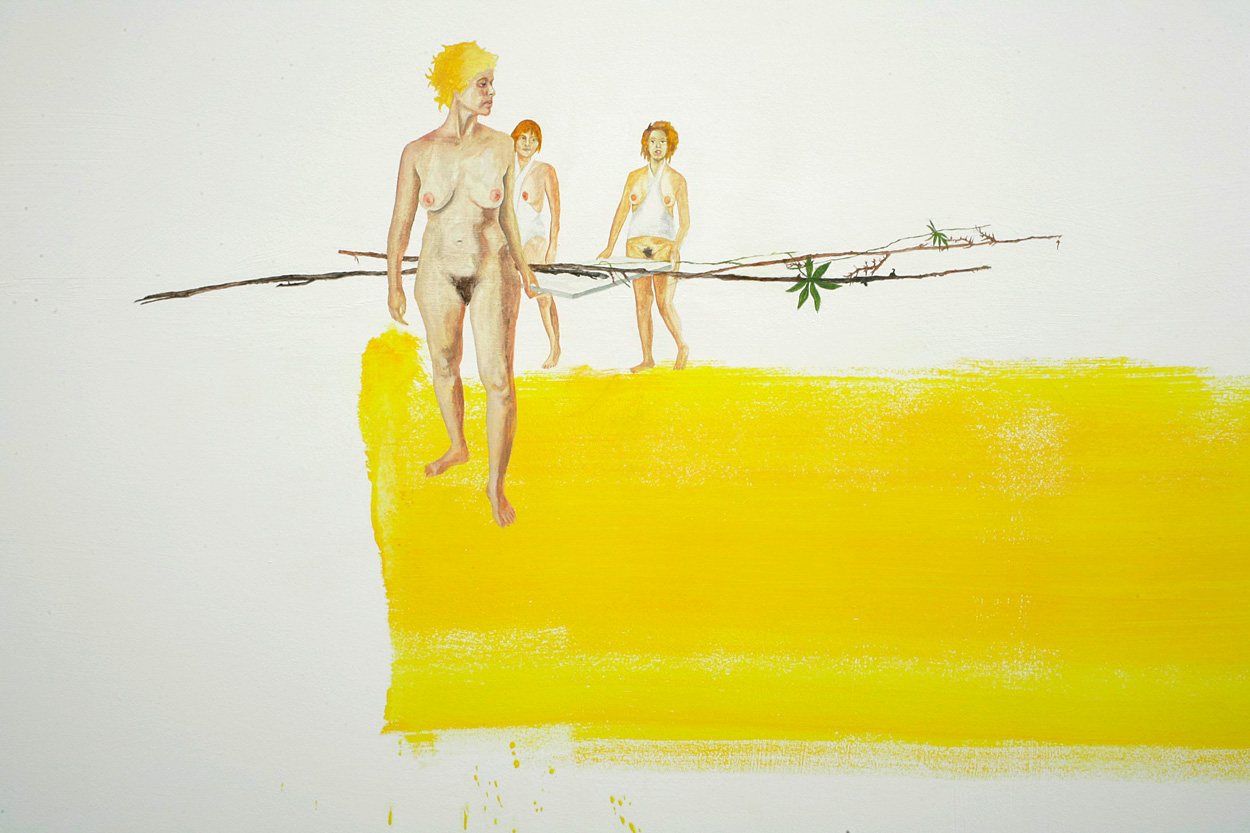












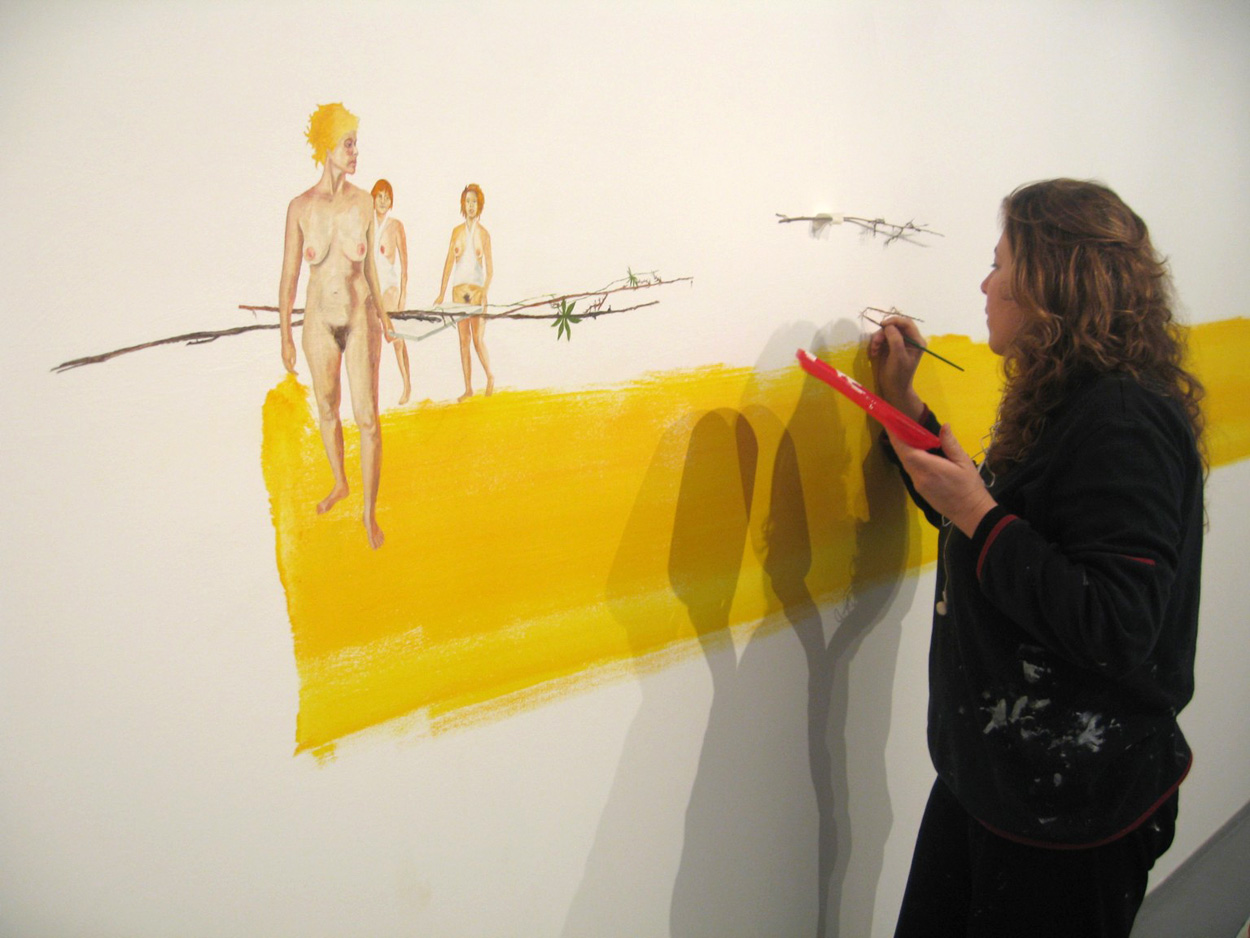
Alexandra’s Journey
Galit Landau Epstein
Between Utopia and Tropia: Once upon a time, in a faraway land, there was an island called Utopia. Its name was derived simultaneously from the Greek ou-topos (no-place) and eu-topos (good place). Written by British humanist Sir Thomas More in 1515, Utopia may be dubbed one of the “forerunners” of modern fantasy literature. More wrote about an ideal society with a perfect socio-political set of rules, well aware that such a community is imaginary, impossible, and nonexistent — a “no-place.”
Carmi’s “Alexantropia” may be read as a personal manifestation of that virtual island, where female warriors-heroines populate abstract masculine realms. The artist creates a tale in which women march, fight, demonstrate, and transpire amidst round, square, and rectangular formats. They climb the gallery wall, and eventually go out, leaving behind traces of flags and branches growing from an object on the exhibition floor.
It is a world of women led by Empress Alexandra, fictive twin of Alexander the Great, who also appears, momentarily, in the space. Alexandra recurs in different variations throughout the show, changing hair color, attire, attributes, and finally — her expression. At times she is triumphant, upright, and confident, at others — humiliated, downcast, and threatened. Sometimes she is alone, while at other instances — with her female companions, returning from battle or from a hunting expedition.
These impossible women declare the exhibition’s major, ongoing battle; a struggle between the figurative, minutely detailed, tiny female, and the powerful, expressive-masculine abstract stain/brushstroke/square/explosion a-la Rothko, Newman, de Kooning, and Pollock. The struggle is symbolic, spiced with humor, conscious of its built-in absurdity. The men are absent from this world. Should they emerge briefly, it is in the form of a monochromatic relief image that froze in time while perpetuating past battles adorning the Parthenon in Athens or the tomb of Alexander the Great in Istanbul. The men are no longer among the living; they are statues demonstrating various theatrical fighting gestures. Among them one may discern Alexander the Great on horseback, wearing a lion headpiece; a centaur defeated by Alexandra; a warrior threatened by an Amazon.
The journey of Alexandra and her companions oscillates between Utopia — the perfect, absolute, feminine world for which the heroines strive, and tropia — the eye’s continuous deviation toward the transient, changing, fragile reality under constant danger of nuclear explosion. This apocalyptic prospect is manifested in brush splatters reminiscent of visual “explosions” on large-scale formats, in stark contrast to the tiny, miniature figures populating the artist’s world.
Three different works amid the myriad fantastical images unfolding in the exhibition encapsulate its overall spirit. They shall be named, respectively, the Defender, the Procession, and the Compass Woman.
The Defender: The defender is situated at the heart of a black olive sphere. Kneeling, she shelters her head against two spectacular birds of “prey,” looking frightened at the viewer. One of the birds appears to be gouging her eye out; the twigs in her hand are too small to protect her. She is naked, save the white cloth wrapped around her neck, possibly a deformed beauty queen’s sash, possibly a quiver’s belt. Her body is exposed to the sun, and the light-shade contrasts enhance the color of her skin. A broad vertical brush stroke, three times her height, stretches by her side. She leaves behind the traces of action. Does she defend herself against the painterly “cascade” threatening to sweep her away? Does she try to confront it with the single, frail branch?
The Procession: A three-woman parade progresses along the broad yellow horizontal brush stroke stretching across the gallery wall. The golden-haired leader stands out in her explicit nudity. She marches on like a primeval woman, her melancholic face turned sideways. In her hand she holds a white plank which functions as a stretcher for twigs and branches, possibly a substitute for a wounded body absent from the scene. Two women walk behind her, holding onto the plank. This is no victory parade, and the stretcher may well indicate the loss of life. The leader’s dejected expression likewise surrenders the nature of the procession held in unsafe territory — at the end of the line, at the edge of an abyss.
Victory parades and processions are a common propagandist theme in the history of art, intended to exalt the ruler returning from the battlefield. The participants in the scene are all men (as opposed to wedding processions such as that of Habsburg Emperor Maximilian I and Mary of Burgundy in 1477, in which the bride took part as well). The male soldiers are “adorned” with uniform, insignia, helmets, swords, and flags. Their bodies are hidden in grand armor, and their faces are often concealed. The female warriors, in contrast, are presented exposed, direct, primeval, specific, and devoid of all signs of rank, place or office. Their power lies in their naked, genuine bodies and facial expressions.
The procession, with its socialist nature, was integral to the rituals customary in kibbutz society to which the artist (who grew up in Kibbutz Beit Hashita) belonged. The appearance of this procession, however, is entirely surreal, calling to mind parades depicted in Fellini’s films. These two highly divergent procession types join visual images of activist women groups such as the Guerilla Girls (female artists active in New York since the 1980s, wearing gorilla masks on their faces), or, on the local-political level, the Israeli Women in Black movement.
This highly stratified procession chooses to function as an ephemeral mural. To wit, its very production embraces its termination, its inevitable end — to disappear, to be erased, to serve as a passing episode accompanying the permanent, eternal works.
The Compass Woman: The compass has a place of honor in the artist’s toolbox. She uses it to demarcate her round format. Concurrently, the readily available, widespread drawing tool also serves as one of the objects attributed to her models. It soon becomes central, starring in two of the works in the exhibition. Its angular shape likens it to a sword, or some other sharp weapon, yet its visual associations send the viewer to Raphael’s monumental fresco The School of Athens (1509-10), featuring key figures from the classical past and present, among them Greek mathematician Euclid (Archimedes according to another version), and Italian architect Bramante who uses a pair of compasses to prepare a scientific drawing for his disciples.
Most of all, however, the kneeling posture of Carmi’s female protagonist and the weapon in her hand allude to William Blake’s late 18th century rendition of God as architect of the universe. In her other hand the figure holds a rather large green branch which is pulled downward, concealing the radiant silver square above which she hovers. The square here, an incarnation of the modern square (Malevich, Mondrian, Albers), becomes a festive, isolated podium. The protagonist prefers to observe it from above, rather than stand on it. She holds the markers of culture (a pair of compasses) and nature (branch) — the two eternal themes in art history, which play a key role in the battle between the sexes: man=culture, woman=nature.
Carmi creates an imaginary world containing multiple visual images: heroines, female warriors, marchers, flag bearers, defenders, women on podium, a procession of women returning from battle, past battles, monumental brush strokes, explosions, an elusive tree, branches, javelins, small flags, Medusa, Gorgon, and a joker.
The artist, the creator of the utopian world, constantly casts her glance to many sides. This sideways glance (hence tropia) juggles between one image and another, between round and square format, between painting and sculpture, gravity and humor, past and present, nature and culture, feminine and masculine, reality and imagination, utopia and dystopia, all and nothing.
The journey has come to an end. Its impressions are recounted on the gallery walls, conscious of their transience and ephemerality. The mural will be erased; the branch and flag installation at the center of the space will be dismantled, and the works comprising it will give way to new pieces. At the end of the journey only the experience will remain; the memory of the figures and the fantastical world that populated it momentarily… And perhaps it was all a dream?

